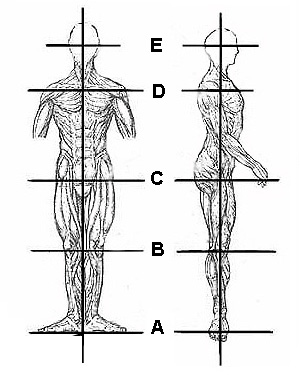
|
.
| Sports Medicine Advisory
ABC'S of Injury Prevention & Peak Performance
By Stephen
M. Apatow, Director of Research and Development, Sports Medicine & Science
Institute.
According to the Merck Manual of
Medical Information for Sports Injuries: "More than 10 million sports
injuries are treated each year in the United States." The seriousness
of this problem points to the need for education initiatives which target
injury prevention.
One of the most significant factors which relates to the mechanism
of joint stress and injury is available information on correct postural alignment.
The subject of fundamental movement mechanics as a prerequisite to sports
specific training is demonstrated in many top level eastern bloc development
programs in sports such as gymnastics. In eastern Bloc countries, classical
ballet based choreography training provides a foundation for the correct
execution of technical sports specific movement. Classical ballet training
is considered the most advanced movement mechanics training in the world,
providing a foundation for the development of joint strength, postural alignment
and precision control of the human frame in space.
In the United States, this crucial developmental step is in many
cases overlooked with sports specific training incorporated without the needed
developmental foundation. (See: Why Eastern Bloc Countries Dominated the Gymnastics Field
in Sydney).
In an effort to reverse this trend, the following information
was compiled to introduce coaches and athletes to classical ballet based
postural alignment ideals.
The Mechanical Ideal
|

The
Mechanical Ideal in Classical Ballet Training.
|
In order to develop precision control
of the human frame and center of gravity, the body must be correctly aligned
and connected as one unit. To do this, the weight must be placed over the
center of the feet (A). Incorrect weightbearing on the foot/ankle complex
corresponds with numerous injuries including ankle sprains, achilles tendonitis
and bone growth patterns (bunions) to accomodate abnormal stresses. As
the legs are bent, the knee caps should track directly over the center of
the ankle and foot (A,B). If a plumbline drops to the inside of the
foot complex, internal rotation of the knee joint is observed which is one
of the most common mechanisms of knee injury and torsional stresses of the
ankle/foot complex ( See: Sports Medicine Advisory
Developmental Problems in Classical Ballet
Training). Hip rotation (C) is the determining factor
for the correct alignment of the knee, ankle and foot. Lack of range
of motion in the hip complex many times contributes to significant torsional
shifts in the pelvis and lumbar spine which contributes to numerous neurological
and lower extremity problems. The upper and lower extremities are
connected by the abdominal and erector muscles of the lower back. Lack
of abdominal strength combined with |
| disconnected alignment of the upper extremity and pelvis
contributes to significant stresses in the lumbar spine. The shoulder
complex (D) is held back and down with concurrent contracture of the pectoral
(chest) and latissimus (upper back) muscles. If the shoulder complex
is positioned forward (hunched shoulders) anterior shoulder injuries (long
head of the bicepts tendon) and neurological stresses occur which affect
the entire arm, wrist and hand complex (tennis elbow, carpal tunnel syndrome).
The correct alignment of the head and neck
(E) is achieved when the base of the skull is aligned over the shoulder complex
with contracture of the sterncleidomastoid muscles in the front of the neck.
Anterior alignment of the head and hyper
lordosis of the cervical spine has been found to contribute to the mechanism
of joint stress and in extreme cases discal herniations.
Sports Specific Applications
As is observed in the sport of gymnastics (Eastern Bloc programs),
the foundation of classical ballet based choreography training is then incorporated
into extreme sports specific technical movement patterns. According
to Dr. Spiros Prassas, Colorado State University and Editor of the ISBS Gymnastics Coaches Information
Service: Gymnastics is a unique sport placing high demands on competitors.
Male gymnasts are required to compete on six apparatuses, while female gymnasts
are competing on four. With the exception of vaulting, which requires the
execution of a single skill, competitors on all apparatuses perform routines
composed of a series of individual skills. It has been estimated that several
hundreds and possibly thousands of skills and skill combinations already
exist, and the number is always increasing with the addition of new ones
(See: ISBS Gymnastics Biomechanical
Research in Gymnastics: What is Done, What is Needed)
Coaches and athletes in all sports are advised to study and incorporate
correct postural mechanics into all strength, speed, flexibility and sports
specific training. This objective will not only result in optimal joint
strength, stability and precision control of the human frame in space but
will also address the mechanism of many common joint injuries.
|
.
Consultations

 Classical Ballet
& Sports Development.
Classical Ballet
& Sports Development.

 Clinics, Seminars, Biomechanics Specialist
Cerficiations.
Clinics, Seminars, Biomechanics Specialist
Cerficiations.
. |
.
For questions or additional information,
contact:
.
.
.
.
.
Back to the Coaches, Athlete and Parent
Resource Center
. |
|
.
|